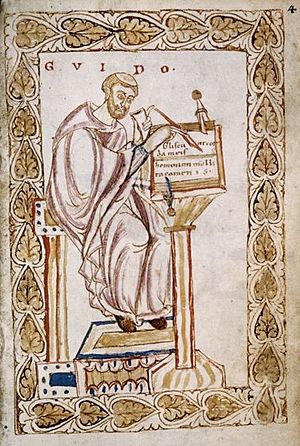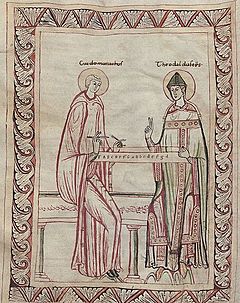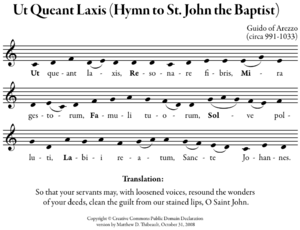Guido of Arezzo facts for kids
Guido of Arezzo (pronounced Gwee-doh of Ah-ret-zoh) was an Italian music expert and teacher who lived a long time ago, from about 991 or 992 to after 1033. He was a Benedictine monk. Many people believe he invented, or at least greatly improved, the way we write music today using lines called a staff. This new system changed music forever in the Western world.
Guido's book, Micrologus, was one of the most important books about music during the Middle Ages. It was read by many people. We don't know a lot about Guido's life, but two old letters he wrote give us some clues. Around 1013, he started teaching at Pomposa Abbey. However, his new teaching methods, which used staff notation, made some of his fellow monks upset.
So, in 1025, he moved to Arezzo. There, a bishop named Tedald supported him. Guido taught singers at the Arezzo Cathedral. His staff notation helped him teach a lot of music very quickly. His book Micrologus became famous across Italy. Even Pope John XIX heard about his ideas and invited him to Rome. Guido got sick during his visit and had to leave, but he promised to return. We don't know much about the rest of his life, but he likely settled in a monastery near Arezzo.
Contents
About Guido's Life
We don't have many records about Guido's life. Some historians think this is because he was a humble monk. For a long time, there were many untrue stories about him. For example, some thought he lived in France or was put in prison for his new ideas.
The main information we have comes from two letters Guido wrote. One was to Bishop Tedald of Arezzo. The other was to his friend Michael of Pomposa, called the Epistola ad Michaelem. These letters help us understand the main events of his life.
His Early Years
Guido was born sometime between 990 and 999 CE. Most experts now agree he was born around 991 or 992. His exact birthplace is not known for sure. Some people think he was born in Arezzo, Tuscany. Others believe he was born near the Pomposa Abbey on the Adriatic coast near Ferrara.
If he was born in Arezzo, he might have learned music at the Arezzo Cathedral. He may have become a singer there.
Time at Pomposa Abbey
Around 1013, Guido went to Pomposa Abbey. This was a very famous Benedictine monastery at the time. There, he became a monk and started to create his new system for writing music. This system used lines to show the notes, making music easier to read and understand.
Guido wrote about his ideas in a book called Regulae rhythmicae. He also worked on an antiphonary (a book of church songs) called Prologus in antiphonarium. In this book, he explained that singers spent too much time memorizing music. He believed his new system would help them learn music faster. This would give them more time to study other religious texts.
He started teaching his singers this new way. Soon, he became known for teaching a lot of music very quickly. People from all over Italy became interested in his ideas. However, some of his fellow monks became jealous and didn't like his new methods. Even the head of the Abbey, Abbot Guido of Pomposa, disagreed with him. Because of this, Guido left Pomposa around 1025. He then moved to Arezzo.
Arezzo, Rome, and Later Life
Arezzo did not have a monastery. So, Bishop Tedald of Arezzo asked Guido to train the singers for the Arezzo Cathedral. It was during this time that Guido started writing his famous book, Micrologus. This book was a guide for singers. It talked about many musical topics, including chant, music with many voices, and his teaching methods.
Guido used his new teaching approach, which helped singers learn much faster. What used to take 10 years to learn could now be learned in just one or two years! His fame spread again, and Pope John XIX invited him to Rome. The Pope had heard about Guido's Regulae rhythmicae and his new way of teaching music.
Guido traveled to Rome around 1028. He showed his methods to the church leaders, and they were very interested. However, Guido became sick while in Rome. The hot summer made him leave, but he promised to come back and explain more of his ideas.
After leaving Rome, Guido likely settled in a monastery near Arezzo. The last record of him is from May 20, 1033, in Arezzo. He died sometime after that date.
Guido's Music Ideas and Inventions
Guido of Arezzo is known for several important contributions to music.
His Writings
Guido wrote four main works:
- The Micrologus (around 1025–1026)
- Regulae rhythmicae (after 1026)
- Prologus in antiphonarium (around 1030)
- Epistola ad Michaelem (around 1032)
The Epistola ad Michaelem is a letter, not a formal music book. The other three books are about music theory and teaching.
The "Do-Re-Mi" System
Guido created new ways to teach music. One of his most famous ideas was using the syllables "ut–re–mi–fa–sol–la" to name musical notes. This system is called solmization. You might know it as "do–re–mi–fa–sol–la."
These syllables come from the first part of each line of an old Latin hymn to Saint John the Baptist, called "Ut Queant Laxis." The notes of this hymn go up one step at a time. Later, the note "Ut" was changed to "Do." A seventh note, "Si" (from "Sancte Iohannes" for Saint John), was added to complete the scale. In English-speaking countries, "Si" was later changed to "Ti" so that each syllable started with a different letter.
The Guidonian Hand
Guido is often given credit for inventing the Guidonian hand. This was a clever way to remember note names by mapping them to different parts of the human hand. While Guido described a basic form of this idea, the full system you might see today was likely developed by others after his death.
In the 12th century, the Guidonian hand became a very popular way to teach and learn music. Musicians would label specific joints or fingertips on their hand with musical notes. This helped them learn and remember the "do-re-mi" syllables. The Guidonian hand made it much easier for musicians to understand and create music. It helped them sing and memorize longer pieces of music, saving a lot of time.
Guido's Lasting Impact
[[multiple image | align = right | image1 = Guido Aretino Florence.jpg | width1 = 150 | image2 = Guido Monaco, statue.JPG | width2 = 200 | footer = Statue of Guido by Lorenzo Nencini in Florence (left); Salvino Salvini's statue of Guido in Arezzo ]] Right after Guido's death, many people wrote about his work, especially his book Micrologus. Other music experts expanded on his ideas.
Guido of Arezzo is still remembered today. Many things are named after him. For example, a computer music notation system is called GUIDO music notation. There is also an international music competition in Arezzo called the "Concorso Polifónico Guido d'Arezzo." A street in Milan, Italy, is also named Via Guido D'Arezzo.
In 1950, a special committee held events to celebrate 900 years since Guido's death.
See also
 In Spanish: Guido de Arezzo para niños
In Spanish: Guido de Arezzo para niños




